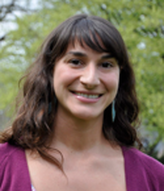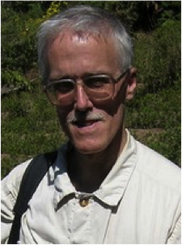Keynote Speakers at PSUxLing 2014
Alumna Speaker: Dr. Rosa Guzzardo Tamargo
|
Rosa Guzzardo Tamargo, a native of Puerto Rico, received her PhD in Spanish linguistics from Penn State in 2012. Since then, she has been working as a member of the faculty of the Universidad Nacional de Puerto Rico, Río Piedras. Her research focuses on bilingualism, language processing, psycholinguistics, and code-switching. Her dissertation work, which entailed an examination of comprehension costs in code-switching using experimental methods, was funded by a National Science Foundation Improvement Dissertation Award.
|
Talk:
Spanish-English code-switching in State College,
New York, and Puerto Rico
When bilinguals interact with other bilinguals, they sometimes codeswitch between their two languages. However, the ways in which bilinguals codeswitch, that is, the types of words and phrases involved in their switches, are not always the same. In this talk, I will present the results of several projects on Spanish-English codeswitching in Pennsylvania, New York, and Puerto Rico. The data were collected by means of different tasks and techniques, including eye-tracking, self-paced moving window, sociolinguistic interviews, and judgment tasks. Some of the studies examine codeswitching practices and preferences in general, while others focus on a particular type of codeswitch, one involving the auxiliary phrase. I will discuss similarities and differences in the way that these speakers engage in this bilingual practice.
When bilinguals interact with other bilinguals, they sometimes codeswitch between their two languages. However, the ways in which bilinguals codeswitch, that is, the types of words and phrases involved in their switches, are not always the same. In this talk, I will present the results of several projects on Spanish-English codeswitching in Pennsylvania, New York, and Puerto Rico. The data were collected by means of different tasks and techniques, including eye-tracking, self-paced moving window, sociolinguistic interviews, and judgment tasks. Some of the studies examine codeswitching practices and preferences in general, while others focus on a particular type of codeswitch, one involving the auxiliary phrase. I will discuss similarities and differences in the way that these speakers engage in this bilingual practice.
Edwin Erle Sparks Professor: Dr. John Lipski
Talk: Language switching constraints: more than syntax? Data from Media Lengua
What do subject pronouns, interrogative words, and sentential negators have in common? In many studies of intra-sentential code-switching it has been claimed that switches immediately following these three categories are disallowed or very infrequent. Teasing apart the contributions of lexically-projected syntactic constraints as opposed to purely lexical issues (e.g. language-tagging) is complicated by the fact that substantially different morphosyntactic systems are often at stake: presence or absence of null subjects, clitics, verb raising, do-support. In order to probe more deeply into the possibly “special” status of these three categories a test case is presented, involving languages that not only share identical phrase structure and syntactic mechanisms while having non-cognate lexicons, but which also employ exactly the same system morphemes except for pronouns, negators, and interrogative words. The languages are Quechua and Media Lengua (ML). ML is a stable relexified language spoken in northern Ecuador and consisting of Quechua morphosyntax, including all affixes and syntactic structures, while all lexical roots are derived from Spanish. Experimental data (involving speeded acceptability judgments and concurrent memory-loaded repetition) were collected from trilingual speakers (Spanish, Quechua, ML), using utterances in Quechua, ML, and containing various mixtures of Quechua and ML. In the acceptability judgments there were no significant differences in the proportion of “no” responses among single-word switches of subject pronouns, negators, interrogative words, or items belonging to traditional lexical categories (nouns, verbs, adjectives). The data from the repetition experiment, however, tell a different story: spontaneous language shifts occurred with 30% of the mixed stimuli, showing a powerful main effect for category for relevant substitutions (either the switched element or surrounding elements in order to achieve a monolingual string). Post-hoc tests reveal significant differences between lexical items and interrogatives and between lexical items and negators, but not between lexical items and subject pronouns. The fact that negative and interrogative elements show greater resistance to language-switching even in identical morphosyntactic frames suggests that logico-semantic factors also play a role. The results of these experiments also potentially shed light on the lack of a cline of intermediate variants between Quechua and Media Lengua, suggesting that relexification is not simply an extreme case of borrowing, but rather represents a quantum-like jump different from both creolization and borrowing.
What do subject pronouns, interrogative words, and sentential negators have in common? In many studies of intra-sentential code-switching it has been claimed that switches immediately following these three categories are disallowed or very infrequent. Teasing apart the contributions of lexically-projected syntactic constraints as opposed to purely lexical issues (e.g. language-tagging) is complicated by the fact that substantially different morphosyntactic systems are often at stake: presence or absence of null subjects, clitics, verb raising, do-support. In order to probe more deeply into the possibly “special” status of these three categories a test case is presented, involving languages that not only share identical phrase structure and syntactic mechanisms while having non-cognate lexicons, but which also employ exactly the same system morphemes except for pronouns, negators, and interrogative words. The languages are Quechua and Media Lengua (ML). ML is a stable relexified language spoken in northern Ecuador and consisting of Quechua morphosyntax, including all affixes and syntactic structures, while all lexical roots are derived from Spanish. Experimental data (involving speeded acceptability judgments and concurrent memory-loaded repetition) were collected from trilingual speakers (Spanish, Quechua, ML), using utterances in Quechua, ML, and containing various mixtures of Quechua and ML. In the acceptability judgments there were no significant differences in the proportion of “no” responses among single-word switches of subject pronouns, negators, interrogative words, or items belonging to traditional lexical categories (nouns, verbs, adjectives). The data from the repetition experiment, however, tell a different story: spontaneous language shifts occurred with 30% of the mixed stimuli, showing a powerful main effect for category for relevant substitutions (either the switched element or surrounding elements in order to achieve a monolingual string). Post-hoc tests reveal significant differences between lexical items and interrogatives and between lexical items and negators, but not between lexical items and subject pronouns. The fact that negative and interrogative elements show greater resistance to language-switching even in identical morphosyntactic frames suggests that logico-semantic factors also play a role. The results of these experiments also potentially shed light on the lack of a cline of intermediate variants between Quechua and Media Lengua, suggesting that relexification is not simply an extreme case of borrowing, but rather represents a quantum-like jump different from both creolization and borrowing.


